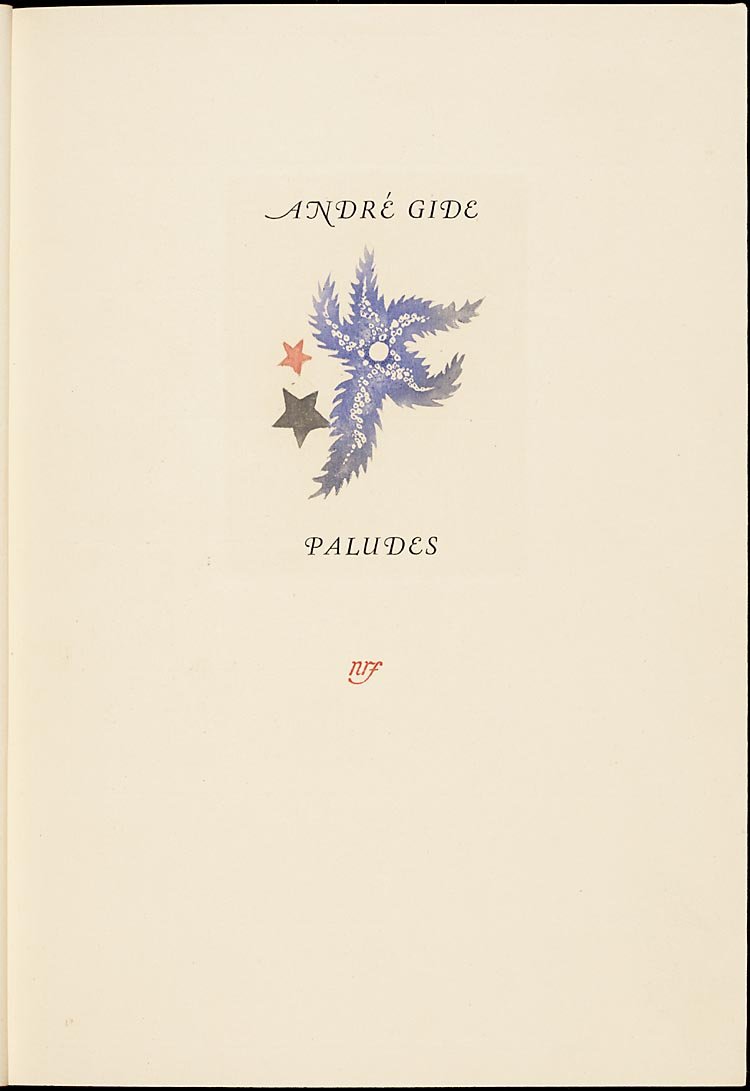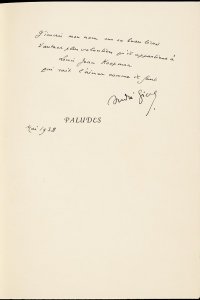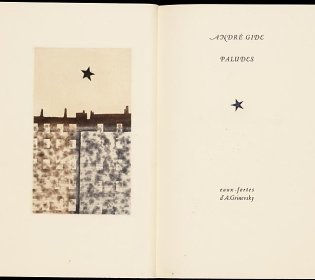Paludes
- Year:
- 1930
- Author:
- André Gide (1869 - 1951)
- Artist:
- Alexandra Grinevski (1899 - 1976)
- Publisher:
- Éditions de la Nouvelle revue française
Satire and scandal
Gide entered the world of Symbolist literature in 1891 when he was introduced to Mallarmé. That very same year, he also met Oscar Wilde. Nervous moods and emotional crises defined his younger years. As a homosexual, he had a loose lifestyle, but he did marry his niece Madeleine Rondeaux in 1895- a remedy against homosexuality that was fashionable at the time. His novels began to cause scandals as he lashed out more clearly against hypocrisy, Catholicism, and colonialism. According to critic Menno ter Braak, it was mostly 'the distaste for this kind of jovial, mechanical ossification' that 'drove Gide to communism'. Ter Braak read his diary, Pages de journal, 'as a protest against European morality of the bourgeoisie that has developed into a sport'. He suspected that Gide's communist leanings were considered 'amateurish' by hardcore communists. Years later, Gide was to take a stance against the dictatorship of communism in Russia.
Homosexuality and communism were two interests he shared with Dutchman Jef Last, who held an implausible number of jobs: farmer, miner, fisherman, navy sailor, assistant manager at Enka, factory labourer, taxi driver, gardener, head of the film ratings board, secretary, and man of letters. He published his memoirs about Gide in 1966: Mijn vriend André Gide ('My friend André Gide'). Last is one of the few Dutchmen to be commemorated in any of Gide's biographies- Stols for instance isn't even mentioned. In 1936 he travelled to Russia with Gide, where the famous author was given a warm welcome: special carriages on the train, factory personnel on parade, banquets, cheering crowds, and Stalin's personal bed in the dictator's dacha offered to him for the night. None of this impressed Gide: he mainly noticed the failure of the communist experiment, and wrote Retour de l'URSS (1936).
In 1895 Gide published Paludes, a light-hearted satire of literary Paris. He started working on it in North Africa, and then travelled to Switzerland for his health, meanwhile working on the novel Les Nourritures terrestres. He experienced a short but romantic affair with a boatswain on Lake Como, and wrote to his mother about it in covert terms. He imposed a strict daily rhythm upon himself: five hours of piano playing, four hours of walking in the mountains, two hours of bathing and gymnastics, and writing, reading, and sleeping. The ironic tone of Paludes camouflaged Gide's previous, rather desperate condition, making the book one of the first modern French narratives (according to Nathalie Sarraute and Roland Barthes).
Rituals of the literary salons
Paludes dealt with the Parisian salons and the young Symbolist writers who convened each Tuesday evening at Mallarmé's home during his famous mardis. Symbolism as a movement and Mallarmé himself weren't a source of derision for Gide, but he did take a critical view of the movement, and wasn't fond of its affected excrescences. Paludes is very ironic and unpoetic. It's a story within a story, featuring a writer who is writing Paludes; the characters discuss both the author and the book, the protagonist of which is named Tityre (a reference to Tytyrus from Virgil's shepherd poems). He lives a lonely life in an isolated tower, without doing much of anything. The main narrator meanwhile leads a public life and subjects himself to the rituals of the literary salon, but does little else: he visits his friends, receives them in his home, and tells everyone how his writing is coming along. The book ends where it began, with a visit from a friend who asks him what he is doing. The answer is once more: 'writing.' As soon as Gide had finished the book, he returned from his Swiss isolation to Paris.
The 1930 edition is a nicely balanced book with one frontispiece, 11 illustrations and 8 smaller vignettes: all copper engravings in several colours. The illustrator, Alexandra Grinevsky, was the first wife of artist and filmmaker Alexandre (Alosha) Alexeieff. Originally, he had been supposed to make the illustrations. Alexeieff developed an animation technique in the 1930s on which he, Claire Parker (his wife-to-be), Etienne Raik and Grinevsky collaborated. Grinevsky's role in the production team was not entirely clear. She divorced Alexeieff in 1931 (she had met him when she was 19, and they had a daughter together). She worked in Etienne Reich's movie studios from 1945 until her death. Very little biographical information is known about her. As far as we know, she didn't illustrate more than five books. Besides Gide's Paludes, these are: Deux artistes lyriques by Valery Larbaud (1929) and three translations: the novel L'archidiable Belphégor by Machiavelli (1930); Tarass boulba by Gogol (1931), and Les Hauts de Hurle-Vent by Brontë (1947). Pierre Normand wrote of this that the illustrations were interesting, undisciplined and sometimes unprofessional. Grinevsky was born in St. Petersburg in 1899 and died in Paris in 1976.
Dedication copy
The copy of Paludes in the Koopman Collection has a double connection with the Netherlands: it was printed by a Dutchman, and was also dedicated to a Dutch collector by Gide personally. Gide wrote in the front of the book: 'I write my name in this beautiful book with great pleasure, since it belongs to Louis Jean Koopman, who knows how to appreciate books like this.' That Koopman did, is demonstrated by the full leather binding he had made for this book by renowned bookbinder Semet et Plumelle (Paris). These same bookbinders also produced its deluxe slipcase. Bookbinder Marcellin Semet and gilder Georges Plumelle were partners from 1925 to 1955, after which Plumelle continued on his own until 1980. Their bindings often display beautiful, modern patterns, but for the Koopman Collection, which contains 21 signed Semet et Plumelle bindings, the binders created beautifully coloured, but sober bindings. This binding is deep blue, while others are ochre, brown, green and red. These simple, undecorated bindings are called Jansenist bindings.
Bibliographical description
- Description:
- Paludes / André Gide ; eaux-fortes d'A. Grinevsky. - [Paris] : Éditions de la Nouvelle revue française, 1930. - [133] p. : ill. ; 25 cm
- 1st edition:
- 1895
- Edition:
- 360 copies
- Printer:
- A.A.M. Stols (Maastricht) (tekst); Edmond Rigal (Fontenay-aux-Roses) (etsen)
- This copy:
- Number 95 of 335 on Dutch Pannekoek
- Typeface:
- Lutetia
- Bookbinder:
- Semet & Plumelle (Parijs)
- Note:
- With autograph dedication from André Gide to Louis Koopman
- Bibliography:
- Bénézit 6-454 ; Carteret IV-183 ; In liefde verzameld 127 ; Monod 5351 ; Stols 207
- Shelfmark:
- Koopm A 75
Literatuur
- Menno ter Braak, 'André Gide en de Jordaan', in: Verzameld werk, Deel III. Amsterdam, Van Oorschot, 1949
- Paul van Capelleveen, Sophie Ham, Jordy Joubij, Voices and visions. The Koopman Collection and the Art of the French Book. The Hague, Koninklijke Bibliotheek, National Library of the Netherlands; Zwolle, Waanders, 2009
- Paul van Capelleveen, Sophie Ham, Jordy Joubij, Voix et visions. La Collection Koopman et l'Art du Livre français. La Haye, Koninklijke Bibliotheek, Bibliothèque nationale des Pays-Bas; Zwolle, Waanders, 2009
- C. van Dijk, Alexandre A.M. Stols 1900-1973: Uitgever, typograaf: een documentatie. Zutphen, Walburg pers, 1992
- Julien Flety, Dictionnaire des relieurs français ayant exercé de 1800 à nos jours. Paris,Technorama, 1988
- André Gide, Jef Last, Correspondance 1934-1950. Lyon, Presses universitaires de Lyon, 1985
- Jef Last, Mijn vriend André Gide. Amsterdam, Van Ditmar, 1966
- D.Ja. Severjuchin, O.L. Lejkind, Chudožniki russkoj emigracii, 1917-1941: Biografiĉeskij slovar. Peterburg, Izd. Ĉernyŝeva, 1994
- Pierre Lepape, André Gide, le messager: Biographie. Paris, Seuil, 1997
- Martin Mooij, Aad G. Put, Jef Last. Amsterdam, Heijnis,1963
- Pierre Mornand, 'Livres parues et livres à paraître', in: Le bibliophile, 1 (1931), p. 45-48
- Alan Sheridan, André Gide: A life in the present. Cambridge, MA, Harvard University Press, 1999
- Nanske Wilholt, Voor alles artiste: uitgever Stols en het literaire leven in het Interbellum. Zutphen, Walburg Pers, 2001







